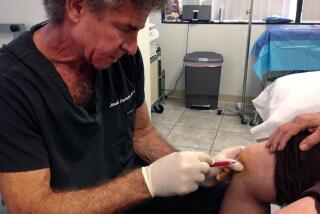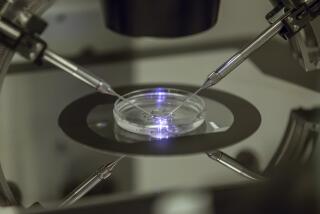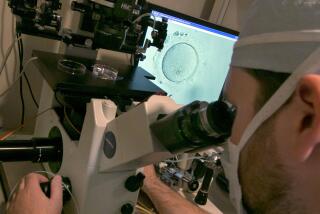Bush Decision Draws Critics on Both Sides
- Share via
President Bush’s proposed compromise on stem cell research drew sharp criticism from prominent scientists Thursday who said that providing funds only for work on a small number of existing stem cell groups may seriously hinder research.
At the same time, Bush’s willingness to allow any federal funding for stem cell research drew a stinging rebuke from the nation’s Roman Catholic bishops, whom the president has assiduously courted. But criticism from another important religious constituency, the 15.9-million-member Southern Baptist Convention, was muted.
For the record:
12:00 a.m. Aug. 15, 2001 FOR THE RECORD
Los Angeles Times Wednesday August 15, 2001 Home Edition Part A Part A Page 2 A2 Desk 1 inches; 33 words Type of Material: Correction
Stem cell research--A Friday story about reaction to President Bush’s decision on stem cell research misidentified the president of the Southern Baptist Convention’s Ethics and Religious Liberty Commission. He is Richard Land.
In his nationally televised speech, Bush said he would allow the federal government to pay for research using lines of stem cells that already have been created. That way the government would not be involved in the destruction of additional embryos, Bush suggested. Research would be able to continue using roughly 60 cell lines that already exist, he said.
But scientists immediately questioned that claim.
“I was in part surprised by his comments tonight,” said Dr. Douglas Melton, chairman of cellular and molecular biology at Harvard University and a leading stem cell expert. “I do not know of 60 existing cell lines. I haven’t counted them up, but I believe that there’s closer to 10” that have been described in published literature.
“I think it’s very unfortunate,” said David Baltimore, president of Caltech. “What he’s done is exactly what I was worried about--which is to assume that the existing lines have all the power that we need.”
A cell line is a set of cells all of which are derived from one or a few originals. They are grown in nutrients that allow them to live and divide--often seemingly indefinitely--in the laboratory. Because the cells in any given line all have the same ancestors, they are genetically close to identical.
The stem cell lines Bush was referring to were originally derived from very young human embryos at a time when the cells had made few or no commitments to become one type of tissue or another. Given the right chemical signals, they can, in theory, be transformed into many different types of cells.
Researchers hope that, by harnessing the ability of stem cells to transform themselves, therapies can be developed for diseases and injuries--growing new cells to fix injured spinal cords, for example, or developing new ways to treat diabetes.
Even if 60 stem cell lines really do exist, the limits Bush has proposed pose many potential problems, researchers said.
One problem is that many of the cell lines are owned by private companies, which may not be willing to share them.
“We are taking the risk as a nation and a society that private entities will now develop therapies that would have developed publicly,” said Dr. Arthur Lander, chairman of the department of developmental and cell biology at UC Irvine.
Dr. Gerald S. Levey, provost for medical sciences and dean of the school of medicine at UCLA, raised a similar concern. Private control of stem cells “raises questions about how many of those will actually be made available for research scientists at universities and what the terms and conditions will be for that availability.”
Moreover, noted Baltimore, it is not at all clear that the existing cell lines have the ability to become all the tissues that scientists might want them to become. Some might turn out not to be usable at all.
It is also possible that some of the existing cell lines may have lost their potency during their time in cell culture or accumulated genetic mistakes, scientists said.
An additional concern is that Bush’s plan “stops research related to understanding the origin and early development of stem cells since you can’t create new stem cells under these guidelines,” said Dr. Larry Kedes, director of the USC Institute for Genetic Medicine.
Among leaders of religious groups, Bishop Joseph A. Fiorenza, president of the U.S. Conference of Catholic Bishops, called Bush’s decision “morally unacceptable.”
“We hope and pray that President Bush will return to a principled stand against treating some human lives as nothing more than objects to be manipulated and destroyed for research purposes,” Fiorenza said.
But criticism from William D. Land, president of the Southern Baptist Convention’s Ethics and Religious Liberty Commission, was subdued.
Land, who was in frequent contact with senior White House officials leading up to Bush’s address, said the decision would “de-energize” the president’s support among anti-abortion Christians, but he suggested that any political damage would not be irreparable.
“This decision, while it deeply disappoints me, does not grieve me because he does not agree to provide federal funding for the destruction of any more embryos,” Land said. He added, however, that Bush’s willingness to allow federal funds to go to research on any stem cells taken from human embryos is morally unacceptable.
Patients and family members who believe they may benefit from stem cell research offered several different perspectives.
“It does everything the scientific community needs and I think a little bit more because it’s certainly raised the level of visibility for the research and the diseases and the injuries, such as spinal cord injury, that can be helped,” said Kent Waldrep, who was paralyzed 27 years ago during a college football game. Waldrep now runs a paralysis foundation bearing his name.
But Ron Stephens, whose 1-year-old son died of juvenile diabetes in 1994, said he was disappointed.
“I don’t know that the compromise is going to take us as far as we need to go,” said Stephens, who has another child with diabetes. “That leaves you short.”
*
Times staff writers Larry Stammer and David Haldane contributed to this story.






